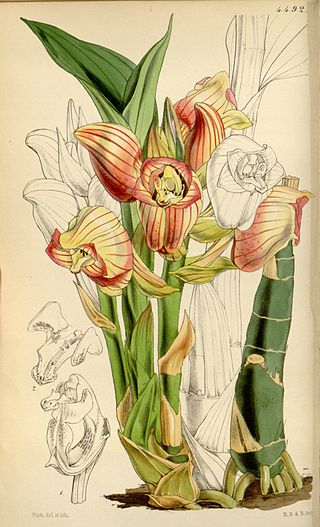
Acanthophippium is a genus of orchid with thirteen species. The name of this genus is derived from the Greek words acanthos ("spiny") and ephippion ("saddle"), referring to the saddle-like labellum of the plants.
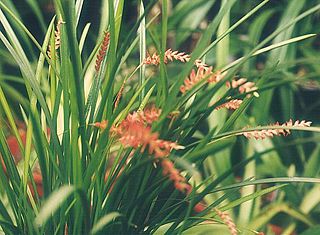
Dendrochilum is a genus of epiphytic, lithophytic and a few terrestrial flowering plants in the orchid family (Orchidaceae). The name of this genus is derived from Ancient Greek words dendron ("tree"), and either cheilos ("lip") or chilos, alluding to either the flowers' large lip or to their epiphytic growth. These orchids are popular among fans of non-traditional orchid curiosities.

Cephalantheropsis is a genus of orchids, comprising 4 accepted species distributed in China, Japan, the Eastern Himalayas and Southeast Asia.

The ornamental orchid species Phalaenopsis hieroglyphica is native to certain islands of the Philippines. Its flowers are creamy white with transverse markings that resemble glyphs. Through hybridization, growers have successfully created flowers with different shapes and colors while retaining the glyphs. Since 1975, the species has been protected under Appendix II of the Convention on International Trade in Endangered Species of Wild Fauna and Flora (CITES).

Aerides lawrenceae is a species of plant in the family Orchidaceae. It is endemic to the Philippines. Its natural habitat is subtropical or tropical moist lowland forests. It is threatened by habitat loss and overcollection.

Paphiopedilum fowliei is a species of plant in the family Orchidaceae. It is endemic to Palawan in the Philippines. Its natural habitat is subtropical or tropical moist lowland forests. It is threatened by habitat loss.
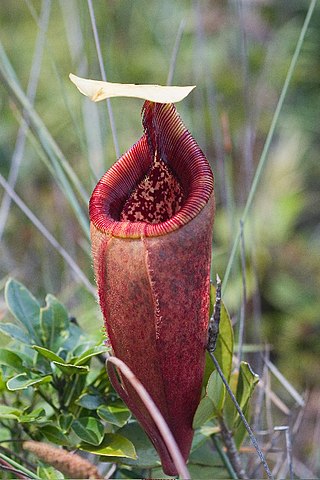
Nepenthes mantalingajanensis is a tropical pitcher plant known only from the summit region of Mount Mantalingajan, the highest point on the Philippine island of Palawan, after which it is named.

Amesiella philippinensis is a species of orchid endemic to the Island of Luzon in the Philippines. Like Vanda falcata it was mistaken as an Angraecum species, due to the white, long-spurred flowers. The plant produces rounded leaces up to 5 cm in length. Three or four white, fragrant flowers of 3 cm in width are produced on short inflorescences. The labellum is yellow in the throat. It occurs at lower altitudes than Amesiella monticola and has a shorter spur.
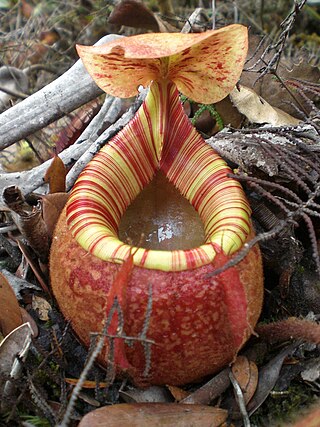
Nepenthes peltata is a tropical pitcher plant known only from the upper slopes of Mount Hamiguitan on the island of Mindanao in the Philippines. It is characterised by a peltate tendril attachment and conspicuous indumentum. The species typically produces ovoid pitchers with a prominent basal crest and large nectar glands on the lower surface of the lid.

Dracula vampira is an epiphytic orchid species, endemic to Ecuador.

Acanthophippium javanicum is a species of orchid and the type species of its genus. It is found in West Malaysia, Borneo, Java, Sumatra and New Guinea.
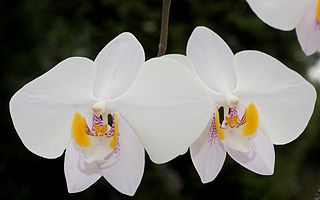
Phalaenopsis philippinensis is an endemic species of orchid found from Luzon island in the Philippines.
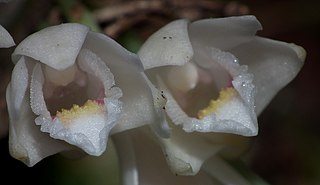
Dendrobium milaniae is flower of the Orchid family found in Leyte, Visayas in the Philippines, where it is found growing as an epiphyte above bodies of water at elevations up to 600 metres. The flower grows to approximately 1.5 centimetres (0.59 in). The plant is semi-pendulous and sympodial. Pseudobulbs are 10 cm by 2 cm; 3 to 6 green lanceolate leaves are present on the top third of the pseudobulb. Hans Fessel and Emil Lückel named this species in 1996 in Die Orchidee.

Grammatophyllum martae is a species of orchid in the family Orchidaceae. It is endemic to the Philippines.
Pinalia xanthocheila is a species in the plant family Orchidaceae.
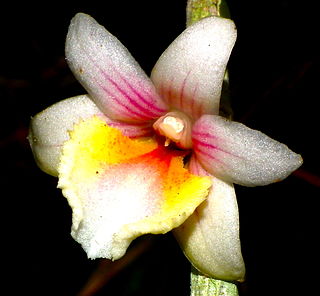
Dendrobium boosii, or Ronny Boos' dendrobium, is a species of plant in the family Orchidaceae endemic to the Philippines.
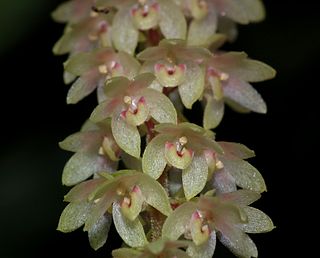
Pinalia polyura, or many-tailed pinalia, is a member of the orchid family endemic to the Philippines. It is semi-pendulous and sympodial, with pseudobulbs that are 20 cm long, 1 cm in diameter, and somewhat club shaped. Each new growth begins halfway along the previous year's pseudobulbs, making the plant longer each year. Each pseudobulb has about 5 shiny, lanceolate leaves approximately 15 cm long and 2 cm wide. Inflorescences appear at the upper portion of the plant and are pendulous, about 10 cm long and bear up to 40 flowers each 1.5 cm in diameter. It grows as an epiphyte and sometimes as a semi-terrestrial plant at elevations to 2,400 meters.
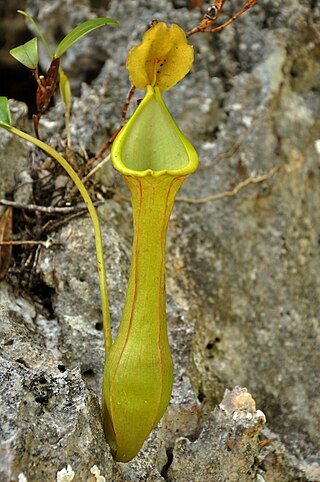
Nepenthes viridis is a tropical pitcher plant endemic to the Philippines. It is known only from coastal areas at low altitude and has been recorded from Dinagat, Samar, and a number of surrounding islets. It is closely allied to the N. alata group of species.

Dipodium paludosum is a terrestrial orchid species that is native to south-east Asia. It occurs in Cambodia, Thailand, Vietnam, the Philippines, Sumatra, Peninsular Malaysia and Borneo. The leaves up to 30 cm long and 2.5 cm wide. The axillary racemes comprise 6 to 12 fleshy flowers which are each up to 4 cm wide and are cream with purple-magenta spots.

Trichoglottis atropurpurea, the dark purple trichoglottis, is a species of orchid endemic to the Philippines. This hot to warm growing epiphyte was first found growing in mangrove swamps in the islands of Biliran, Catanduanes, Mindanao and Polillo. The plant shares the same appearance with T. philippinensis except for the rich dark color of the blooms and slight variation of the perianth. This species was first described in 1877 by the German botanist Heinrich Gustav Reichenbach, an expert on the orchid family. At that time, thousands of newly discovered orchids were being sent back to Europe, and he was responsible for identifying, describing and classifying many of these new discoveries.





















